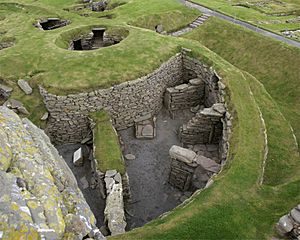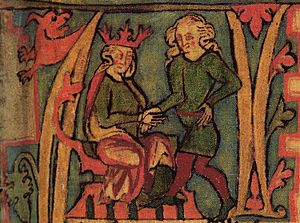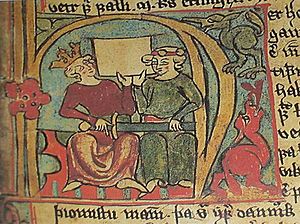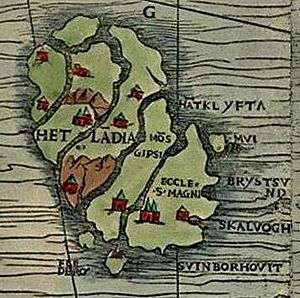History of Shetland facts for kids
The History of Shetland is about the Shetland islands in Scotland. These islands are far north, close to the Arctic. For a long time, the Vikings had a big influence here. Later, from the 1300s, Shetland became part of the Kingdom of Scotland. After that, it joined the United Kingdom.
Contents
Ancient Times in Shetland

Shetland has many ancient sites because people built with stone. There are over 5,000 archaeological sites! The earliest signs of people are from about 4320–4030 BCE. This was during the Mesolithic period (Middle Stone Age).
Later, during the early Neolithic period (New Stone Age), people also lived here. Stone tools called "Shetland knives" were made from a special rock found in Northmavine.
Tall, round towers called brochs were built in Shetland until about 150-200 CE. Some brochs, like the one at Old Scatness, were near good farming land and water. Others, like those at Levenwick and Culswick, were in wilder areas. Many brochs are by the sea or on islands in lochs (lakes), such as Clickimin.
The Romans knew about the Orkney and Shetland Islands. They called them "Orcades." They probably sailed around them and saw the brochs. A "king of the Orcades" was said to have paid tribute to the Roman emperor Claudius in 43 AD. Some old writings even say these islands were part of a Roman province.
However, archaeologists think the Romans mostly traded with the islanders. They probably did this through other people. There is no clear sign that the Romans lived there. But some experts believe the Romans might have ruled the islands directly for a very short time.
We don't know much about the language spoken in Shetland before the Vikings arrived (around 650 to 800 CE). Some experts think it was a Celtic language, like the name of the island Yell suggests.
Viking Arrivals
By the late 800s, the Scandinavians started to invade instead of just raiding. This was because there were too many people in Scandinavia for the available land and resources.
Norsemen settled in Shetland in the 800s. We don't know what happened to the people already living there. The Norse settlers gave the islands their current name. They also brought their laws and language. This language slowly changed into Norn, which was spoken in Shetland until the 1800s.
After Harald Fairhair became king of all Norway, many of his enemies ran away. Some went to Orkney and Shetland. From these islands, they kept raiding Scotland and Norway. So, King Harald gathered a huge fleet of ships. Around 875, he sailed to the islands and took control of Shetland and Orkney. He gave the islands to Ragnvald, Earl of Møre, as a reward. Ragnvald then gave the earldom to his brother, Sigurd the Mighty.
Shetland became Christian in the late 900s and 1000s. This happened because the Norwegian kings, especially Olaf Tryggvason, encouraged it.
Trouble with Norway
In 1194, Sverre Sigurdsson was king of Norway. Harald Maddadsson was the Earl of Orkney and Shetland. Some men from Orkney, led by Hallkjell Jonsson and Olav, formed an army called the eyjarskeggjar. They sailed to Norway. Their chosen king was Olav's young foster son, Sigurd Magnusson.
The eyjarskeggjar were defeated in the Battle of Florvåg near Bergen. King Sverre wanted to be sure his enemy Sigurd was dead, so Sigurd's body was shown to him. King Sverre also demanded that Harald Maddadsson explain his part in the uprising. In 1195, Earl Harald sailed to Norway to make peace with King Sverre. As a punishment, the king took control of Shetland directly. It seems Shetland was never given back to the Earls after this.
Scotland's Growing Interest
When Alexander III of Scotland turned 21 in 1262, he decided to continue his father's plan to take over the western and northern islands. He sent a formal request to the Norwegian King Håkon Håkonsson.
Norway had become a strong country after years of civil war. King Håkon refused Alexander's demands. The Norwegians believed all the islands in the North Sea belonged to Norway. To show his strength, King Håkon gathered a huge fleet. It was said to be the biggest ever assembled in Norway. The fleet met in Breideyarsund in Shetland, which is probably Bressay Sound today. Then, the king sailed to Scotland. His goal was to talk, with his army ready as backup.
Alexander III kept the talks going, waiting for the autumn storms to begin. Finally, King Håkon lost patience and decided to attack. But a big storm hit, destroying many of his ships. Others couldn't even land. The Battle of Largs in October 1263 wasn't a clear win for either side. Both claimed victory. But King Håkon Håkonsson's situation was hopeless. He returned to Orkney with an unhappy army and died there on December 17, 1263. His death stopped Norway from expanding further into Scotland.
King Magnus Lagabøte, Håkon's son, decided to make peace with Scotland. In the Treaty of Perth in 1266, he gave up Norway's furthest lands, including the Isle of Man and the Hebrides. In return, Scotland paid 4,000 marks and an annual payment of 100 marks. The Scots also agreed that Orkney and Shetland belonged to Norway.
One big reason Norway wanted peace was that trade with England was suffering. In 1223, England demanded Norway make peace with Scotland for trade to continue. In 1269, this agreement was expanded to allow free trade between all three countries.
Shetland Becomes Scottish

In the 1300s, Norway still saw Orkney and Shetland as its own. But Scotland's influence was growing. In 1379, the Scottish earl Henry Sinclair took control of Orkney for the Norwegian king Håkon VI Magnusson.
By 1384, Norway was much weaker after the Black Plague. In 1397, it joined the Kalmar Union with Denmark and Sweden. Over time, Denmark gained more control over Norway.
King Christian I of Denmark and Norway had money problems. When his daughter Margaret got engaged to James III of Scotland in 1468, he needed money for her dowry (a payment from the bride's family).
Under old Norse law, the king didn't own all the land. People owned their own land. So, the king only owned a small part of Shetland. Without telling his own council, King Christian made a deal on September 8, 1468. He used his personal lands in Orkney as a guarantee for 50,000 Rhenish guilders. On May 28, 1469, he also used his Shetland lands as a guarantee for 8,000 Rhenish guilders.
The agreement said that Christian or his future kings could buy the islands back. They would pay a fixed amount of gold or silver. It also said that Norway's language and laws should stay the same. In 1470, William Sinclair, 1st Earl of Caithness gave up his title to James III. Then, on February 20, 1472, the Northern Isles officially became part of the Scottish Crown.
Scottish kings, like James III, stopped all attempts by the Danes to get the islands back. They didn't say the Danish claim was wrong. They just avoided the issue.
Hansa Trade Era
From the early 1400s, Shetlanders sold their goods through the Hanseatic League. These were German merchants. The Hansa bought salted fish, wool, and butter. They sold salt, cloth, beer, and other goods to Shetland.
The late 1500s and early 1600s were greatly influenced by Robert Stewart, who was given the islands by his half-sister Mary Queen of Scots. His son, Patrick, started building Scalloway Castle. But after Patrick was executed in 1609, the Crown took back Orkney and Shetland. They were given to William Douglas, 7th Earl of Morton in 1643. The Morton family held these rights on and off until 1766. Then, James Douglas, 14th Earl of Morton sold them to Sir Laurence Dundas.
British Rule and Changes
When the Act of Union 1707 was passed, German merchants were no longer allowed to trade with Shetland. This caused an economic downturn for Shetland. Scottish and local traders weren't as good at selling salted fish. However, some local wealthy landowners started their own ships to export fish to Europe. This made things harder for independent farmers, who now had to fish for these landowners.
The Crofters' Holdings (Scotland) Act 1886 helped these farmers. The Liberal prime minister William Ewart Gladstone passed this law. It allowed farmers, who were almost like servants to the landowners, to become owners of their own small farms.
For 200 years after Shetland was pawned, the islands were often passed between the Crown and nobles. This was a way to make money. Laws were changed, and the local language was suppressed. This process is called "feudalisation" by historians. It was how Shetland became part of Scotland, especially in the 1600s. However, this term is a bit confusing. Feudal law means the Crown owns the land, but the Crown never truly owned all of Shetland. Even in the 1900s, courts said no land in Shetland was under feudal ownership.
The Crown might have thought that over time, they gained ownership. They certainly acted that way. But the Treaty of Breda (1667) showed this was wrong. This treaty was about sharing colonial lands after a war. The Danish delegation tried to get Shetland back. Because the treaty was so important, King Charles II agreed that the original marriage agreement was still valid. This meant his and previous kings' actions of giving out feudal charters for the islands were illegal.
In 1669, Charles II passed his Act for annexation of Orkney and Shetland to the Crown. This law put things back to how they were in 1469. He made Shetland a "Stewartry," which meant it was directly controlled by the King and his officers. Today, we might call this a Crown Dependency. Charles II also said that if there was a "general dissolution of his majesty's properties" (meaning the Act of Union), Shetland should not be included. Shetland could not become part of Scotland or the new union with England. The marriage agreement also meant that any laws passed before or after the pawning had no effect on Shetland.
With Parliament's agreement, Charles was taking back the exclusive rights to the islands for the Crown forever. He was specifically keeping Shetland out of the coming Act of Union. He even said the Act of Union would be invalid if Shetland was included.
Several attempts were made in the 1600s and 1700s to buy the islands back, but they failed. After a legal fight with William, Earl of Morton, Charles II confirmed the pawning document with a Scottish law on December 27, 1669. This officially made the islands a Crown dependency. In 1742, another law gave the estates back to a later Earl of Morton. However, the original law had said that any future law about the islands' status would be "null, void and of no effect."
Despite all this, Shetland's connection to Norway has lasted. When Norway and Sweden separated in 1906, Shetland sent a letter to King Haakon VII. It said that Norway's flag was always welcome in Shetland. It also said that Shetlanders still saw Norway as their "mother-land" and were proud of the time their ancestors were ruled by Norwegian kings.
Napoleonic Wars
Around 3,000 Shetlanders joined the Royal Navy during the Napoleonic wars from 1800 to 1815.
World War II and the Shetland Bus
During World War II, a special Norwegian naval unit was formed in Shetland. It was called the "Shetland Bus". It started in autumn 1940, first at Lunna and later in Scalloway. Its job was to carry out secret missions on the coast of Norway.
About 30 fishing boats, used by Norwegian refugees, were gathered in Shetland. Many were rented, and Norwegian fishermen volunteered to operate them.
The Shetland Bus made secret trips between Norway and Shetland. They carried brave people from Company Linge (a Norwegian special forces unit), spies, refugees, and military supplies. Many people escaping the Germans, and important information about German activity in Norway, were brought back to the Allies this way. They also laid some mines and attacked German ships. At first, the unit was under British command, but later Norwegians joined the command.
The fishing boats made 80 trips across the sea. German attacks and bad weather caused the loss of 10 boats, 44 crew members, and 60 refugees. Because of these losses, they decided to get faster boats. The Americans gave them three submarine chasers (HNoMS Hessa, HNoMS Hitra and HNoMS Vigra). None of the trips with these faster vessels resulted in any losses.
The Shetland Bus made over 200 trips across the sea. The most famous person from the unit, Leif Andreas Larsen (known as Shetlands-Larsen), made 52 of these trips!
Cultural Connections
Old records, archaeological finds, place names, and language all show that Norse culture was very strong in Shetland during the Viking period. A few place names might be from the Picts, an older group of people, but this is debated.
Scientists have studied the genes of people in Shetland today to find out where they came from. It turns out that less than half of Shetlanders have Scandinavian origins. They have about 44% Scandinavian ancestry from both their mothers' and fathers' sides. This suggests that both men and women settled the islands. This was also true in Orkney and parts of Scotland's coast. But in other parts of the British Isles further from Scandinavia, it seems mostly men settled and married local women.
After the islands became part of Scotland, thousands of Scottish families moved to Shetland in the 1500s and 1600s. Trade with Germany and the Netherlands also brought smaller numbers of immigrants from those countries. World War II and the oil industry also led to more people moving to Shetland.
Population Changes Over Time
The number of people living in Shetland has changed a lot over history. Deaths at sea and diseases like Smallpox in the 1600s and 1700s affected the population. But as vaccinations became common, the population grew faster. By 1861, it reached 40,000 people.
This growth led to a lack of food, so many young men left to work in the British merchant navy. 100 years later, the population had more than halved. This was mainly because many Shetland men were lost at sea during the two world wars. Also, many people moved away in the 1920s and 1930s. Today, more people with Shetland backgrounds live in Canada, Australia, and New Zealand than in Shetland itself.
| District | Population | |||||
|---|---|---|---|---|---|---|
| 1961 | 1971 | 1981 | 1991 | 2001 | 2011 | |
| Bound Skerry (& Grunay) | 3 | 3 | 0 | 0 | 0 | 0 |
| Bressay | 269 | 248 | 334 | 352 | 384 | 368 |
| Bruray | 34 | 35 | 33 | 27 | 26 | 24 |
| East Burra | 92 | 64 | 78 | 72 | 66 | 76 |
| Fair Isle | 64 | 65 | 58 | 67 | 69 | 68 |
| Fetlar | 127 | 88 | 101 | 90 | 86 | 61 |
| Foula | 54 | 33 | 39 | 40 | 31 | 38 |
| Housay | 71 | 63 | 49 | 58 | 50 | 50 |
| Mainland | 13,282 | 12,944 | 17,722 | 17,562 | 17,550 | 18,765 |
| Muckle Flugga | 3 | 3 | 0 | 0 | 0 | 0 |
| Muckle Roe | 103 | 94 | 99 | 115 | 104 | 130 |
| Isle of Noss | 0 | 3 | 0 | 0 | 0 | 0 |
| Papa Stour | 55 | 24 | 33 | 33 | 25 | 15 |
| Trondra | 20 | 17 | 93 | 117 | 133 | 135 |
| Unst | 1,148 | 1,124 | 1,140 | 1,055 | 720 | 632 |
| Vaila | 9 | 5 | 0 | 7 | 2 | 2 |
| West Burra | 561 | 501 | 767 | 817 | 753 | 776 |
| Whalsay | 764 | 870 | 1,031 | 1,041 | 1,589 | 1,061 |
| Yell | 1,155 | 1,143 | 1,191 | 1,075 | 957 | 966 |
| Total | 17,814 | 17,327 | 22,768 | 22,522 | 22,990 | 23,167 |
Important Dates in Shetland's History
| Year | Event |
|---|---|
| before 4320 BCE | The first people, from the Mesolithic period, arrive in Shetland. |
| 84 | The Roman fleet, led by Agricola, sees Thule, which might have been Shetland. |
| c. 650 | Norse settlers begin to live in Shetland. |
| 875 | Harald Fairhair takes control of the islands. |
| 1195 | Harald Maddadsson loses control of Shetland. The islands are put directly under the Norwegian king Sverre Sigurdsson. |
| 1379 | The Scottish earl Henry Sinclair takes control of Orkney for the Norwegian king Håkon VI Magnusson. |
| 1469 | Christian I uses Shetland as a guarantee to the Scottish king James III for his daughter's dowry. |
| 1472 | Shetland officially becomes part of the Kingdom of Scotland. |
| 1674 | Battle of Ronas Voe |
| 1700–1760 | Smallpox affects the islands. |
| 18th century | The Norn language slowly disappears. |
| 1707 | The German merchants lose their trading rights in Shetland. |
| 1708 | The capital moves from Scalloway to Lerwick. |
| 1880s | William Ewart Gladstone helps free the farmers from strict landlord control. |
| 1940 | The Shetland bus is set up by the Special Operations Executive. |
| 1972 | Shetland celebrates 500 years of being part of Scotland. |
| 1975 | Lerwick Town Council and Zetland County Council join to form the Shetland Islands Council. |
| 1978 | The oil terminal in Sullom Voe opens. |
Images for kids
-
Map showing the distribution of "brochs", including those in the Shetland isles.






